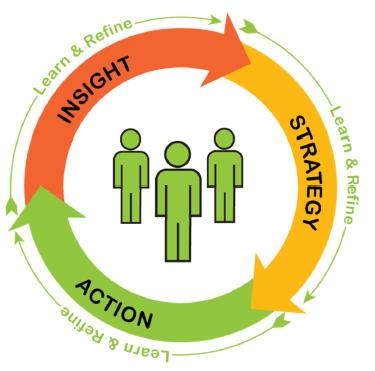Why a Data-Driven Culture Matters for Business Success
In today’s data-rich environment, businesses have unprecedented opportunities to make smarter, more strategic decisions. However, investing in sophisticated analytics tools alone isn’t enough. To fully leverage the power of data, businesses must cultivate a data-driven culture—a company-wide mindset that prioritizes data insights over intuition or assumptions.
Studies show that organizations embracing data-driven decision-making are 23 times more likely to acquire customers and 19 times more likely to achieve above-average profitability. Yet, despite these compelling numbers, many businesses struggle to embed data-driven thinking into their everyday practices.
In this guide, we’ll explore five practical steps for developing a robust, data-driven culture in your organization—one that transforms data into action and drives sustained growth.
Step 1: Establish Clear Leadership and Vision
A successful data-driven culture begins with strong leadership commitment. Leaders must communicate the importance of data-informed decisions clearly and consistently, setting expectations from the top down. Define a compelling vision around data, emphasizing its strategic role in organizational growth and innovation.
Practical ways leaders can support a data-driven vision include:
- Setting clear objectives and Key Performance Indicators (KPIs) tied explicitly to data outcomes.
- Regularly sharing and discussing data insights during meetings.
- Recognizing and rewarding teams for effectively leveraging data to inform strategies and decisions.
Step 2: Improve Data Literacy Across Your Organization
Even the best data tools are ineffective without a workforce equipped to interpret and utilize data effectively. Improving data literacy—the ability to understand, interpret, and communicate data—is critical to fostering a data-driven culture. When employees are comfortable with data, they’re more likely to use insights to inform their daily decisions.
Strategies to enhance data literacy include:
- Offering training sessions or workshops focused on analytics basics.
- Creating accessible resources such as a “data dictionary” that defines key metrics and terminology clearly.
- Encouraging mentorship programs where data-savvy team members coach others.
Step 3: Ensure Data Accessibility and Implement User-Friendly Tools
Data must be easily accessible and usable for a data-driven culture to thrive. Breaking down departmental silos and implementing intuitive, user-friendly tools empowers employees at all levels to engage with and leverage data effectively.
Key steps to improving data accessibility include:
- Deploying centralized Business Intelligence (BI) platforms or dashboards, ensuring real-time, easy-to-understand insights are available across teams.
- Regularly maintaining and cleaning datasets to ensure accuracy and reliability.
- Introducing self-service analytics tools so employees can independently generate reports and analyses without extensive technical assistance.
Partnering with analytics experts—such as Marradata.ai—can facilitate seamless integration and customization of data platforms, aligning them closely with your team’s unique needs.
Step 4: Integrate Data into Your Daily Decision-Making Processes
Creating a genuine data-driven culture requires embedding data analysis deeply into regular workflows and routines. Rather than treating data as an occasional input, make it central to everyday processes and decisions.
Effective integration practices include:
- Regularly starting meetings with a review of relevant metrics and data.
- Requiring data-backed justifications for strategic decisions and new initiatives.
- Ensuring project proposals and reports incorporate clear, data-supported insights to justify recommendations.
By consistently asking, “What does the data say?” during decision-making, teams begin to naturally prioritize evidence-based decisions over subjective judgments.
Step 5: Foster Experimentation and Encourage Continuous Improvement
A data-driven culture not only informs current decisions but also actively drives innovation through experimentation. Encourage teams to test hypotheses, conduct experiments (such as A/B tests), and continuously iterate based on data-driven insights.
To promote experimentation and continuous learning:
- Encourage safe experimentation by framing failures as valuable opportunities for learning rather than setbacks.
- Celebrate data-driven successes publicly, reinforcing the value of using insights in decision-making.
- Create structured feedback loops, allowing teams to refine processes and strategies based on collected data insights continuously.
Overcoming Common Barriers to a Data-Driven Culture
Transitioning to a data-driven culture may encounter challenges such as employee resistance, limited understanding, or technical integration issues. Overcoming these barriers involves:
- Clear communication about how data positively impacts roles and workflows.
- Consistent reinforcement and visibility of successful data-driven outcomes.
- Providing ongoing support, resources, and expertise to assist teams in confidently using analytics tools and interpreting results.
Unlocking Your Organization’s Data Potential
Developing a robust data-driven culture is a strategic investment that transforms organizational effectiveness and competitive advantage. By clearly defining your data-driven vision, empowering your workforce through enhanced literacy, ensuring data accessibility, embedding analytics in daily workflows, and fostering experimentation, your organization can turn insights into impactful actions.
Remember, building this culture is an ongoing journey of refinement and improvement. If your organization needs guidance or support, consider consulting analytics experts who can accelerate your data-driven transformation and maximize your investment in analytics technology.

